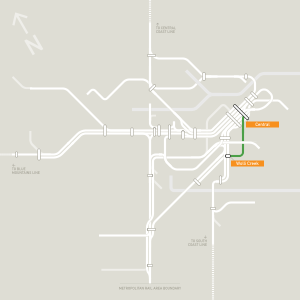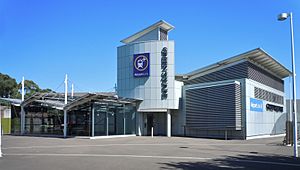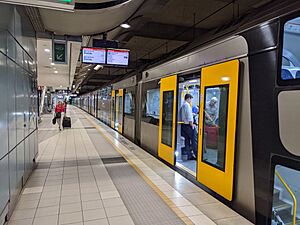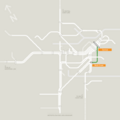Airport Link, Sydney facts for kids
Quick facts for kids Airport Link |
|
|---|---|
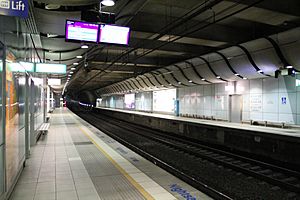
View of the Airport Line as it runs through Mascot.
|
|
| Overview | |
| Other name(s) | Airport Line, New Southern Railway |
| Owner |
|
| Termini | Central Wolli Creek |
| Stations | 5 |
| Service | |
| Operator(s) |
|
| Rolling stock | K, M, A and B sets |
| History | |
| Opened | 21 May 2000 |
| Technical | |
| Line length | 10 km (6.2 mi) |
| Number of tracks | 2 |
| Track gauge | 1,435 mm (4 ft 8 1⁄2 in) standard gauge |
| Electrification | Overhead 1500 V DC |
| Operating speed | 80 km/h (between stations) 60 km/h (at stations) |
The Airport Link (also called the Airport Line) is a railway line in Sydney, Australia. It connects Sydney Airport to the city center and south-western suburbs. This line is super helpful for people traveling to and from the airport.
Most of the stations on the Airport Line are run by a private company called the Airport Link Company. This is part of a special agreement where a private company helps build and run public services. Because of this, there's a small extra fee on top of the usual train ticket price at some stations. The line is used by Sydney Trains' T8 Airport & South line services.
Contents
How the Line Runs
The Airport Link is about 10 kilometers long. A big part of it, about 4 kilometers, is a tunnel dug through rock. Another 6 kilometers is a tunnel through softer ground. The tunnel goes about 23 meters (that's like a 7-story building) underground!
Most of the line is underground. It starts from platform 23 at Central Station. Then it goes into a tunnel near Prince Alfred Park. The tunnel runs under suburbs like Redfern and Waterloo.
At Green Square station and Mascot station, the line is still underground. From Mascot, it turns sharply west under Sydney Airport. It passes under both the Domestic and International airport terminals. Finally, it goes under the Cooks River and comes to the surface at Wolli Creek. Here, it connects with the East Hills line. The whole line has two tracks, one for each direction.
The stations built at the airport, Domestic and International, have bigger lifts and wider ticket gates. This makes it easier for passengers with lots of luggage. Three other new stations were also built: Mascot and Green Square for local residents, and Wolli Creek as a transfer station.
Building the Line
In the 1990s, the government wanted to build a train line to the airport. In 1994, they teamed up with two companies, Transfield Services and Bouygues. This was a "public private partnership." The private company, Airport Link Company, paid to build four of the stations. In return, they could run those stations for 30 years and charge an extra fee. The government paid for the railway tracks themselves and Wolli Creek station.
Construction started in 1995. The goal was to have the line ready for the 2000 Summer Olympics in Sydney. Before this, people mostly used special buses to get to the airport.
A huge machine called a tunnel boring machine was used to dig the tunnels. It arrived from Germany in 1996. This machine helped dig the tunnels without needing too many workers underground. Special safety rules were put in place for workers who had to go into certain parts of the machine.
While the Airport Link was being built, the nearby East Hills Line also got an upgrade. More tracks were added to make train travel smoother. This also changed how trains ran at Central Station, giving the Airport Line its own special platforms (21 and 23).
History of the Airport Link
The Airport Link opened on May 21, 2000, just a few months before the Olympic Games. The government spent about A$700 million on the project, and the private company spent over A$200 million. The private company will hand over ownership of the four stations to the government on May 21, 2030.
Even though the special airport bus service stopped, and taxis and airport parking were expensive, not as many people used the Airport Link as expected at first. The train company hoped that more people would start using it once they got used to it.
In 2001, the private company that ran the stations faced financial trouble. This meant the government had to step in to help. This project, along with another tunnel, made the government and businesses less keen on similar public-private partnerships for a while.
Later, in 2005, the government and the company made a new agreement to help solve the financial issues. The company was later bought by Westpac, a bank. In 2013, another company, Universities Superannuation Scheme (USS), took control of the Airport Link Company.
Station Access Fees
When the line first opened, all stations charged an extra "station access fee" on top of the normal train fare. This fee was for using the stations built by the private company.
In 2011, the NSW Government decided to cover this extra fee for Green Square and Mascot stations. This meant passengers no longer had to pay the surcharge at these two stations. To make up for this, the government pays the Airport Link Company a fixed fee for each person who enters or exits these stations.
After the fee was removed, many more people started using Green Square and Mascot stations. Their passenger numbers went up by 70% in just a few months! However, the extra fee still applies at the Domestic and International Airport stations. Even airport workers don't get a big discount, just a weekly limit on the extra fee.
Because so many more people are using them, Green Square and Mascot stations have become very busy during peak times. Mascot station, for example, saw a 117% increase in passengers between 2015 and 2019. The station was even expanded in 2023 to handle all the extra people.
The special agreement with the private company will end on May 20, 2030. After that, the government will own all the stations, and the extra station access fee will be removed for everyone.
What People Think
One common criticism of the Airport Link is that the trains aren't specially designed for airport travelers. People going to the airport have to share trains with regular commuters, especially during busy mornings. These trains don't have special areas for luggage.
This is different from some other cities. For example, Brisbane's AirTrain has trains with space for luggage, comfy seats, and Wi-Fi. Also, the Brisbane line ends at the airport, so airport travelers aren't mixed with local commuters. Perth's airport train line also shares some issues with Sydney's, but it doesn't charge an extra fee to use the airport stations.
Even though it might seem like all the money from the access fee goes to the private company, most of it actually goes to the NSW Government. Since 2014, the government has received about 85% of the money from these fees. From 2015 to 2018, the NSW Government earned over $197 million from the station access fee.
Images for kids


